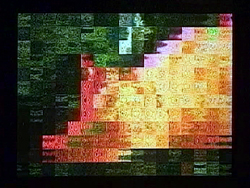In 1951, with the encouragement of Shuzo Takiguchi, Katsuhiro Yamaguchi formed Jikken Kōbō with Shozo Kitadai, Kideko Fukushima, Toru Takemitsu, Joji Yuasa, Hiroyoshi Suzuki, and Kuniharu Akiyama. The collective's activities revolved around the incorporation of technology into art and supported the emergence of the media art genre in postwar Japan. In 1972, Yamaguchi was a central member of Video Hiroba, and in 1975 he presented his work at the São Paulo Art Biennial. He founded the group Āru Jeni in 1982 and has since produced numerous environmental video installations. Among his works are the "Vitrine Series," Image Modulator (1969), Las Meninas (1974-75), and Uzu no naka no onna (1977).
1969, 45 sec, color, sound
1977, 1:30 min, color, sound
1972, 1:30 min, b&w, sound
2010, 162 min, color and b&w, sound, DVD
Computer Movie No. 2
1969, 8 min, b&w, sound
Image Modulator
1969, 45 sec, color, sound
Ooi and Environs
1977, 1:30 min, color, sound
Metastasis
1971, 8 min, color, sound
Oh! My Mother
1969, 14 min, color, sound
Camera, Monitor, Frame
1976, 17:15 min, b&w, sound
Hand No. 2
1976, 7:50 min, b&w, silent
Magnetic Scramble
1968, 30 sec, b&w, silent
Under A Bridge
1974, 13 min, b&w, sound
What a Woman Made
1973, 10:50 min, b&w, sound
Kick The World
1974, 15 min, b&w, sound
Eat
1972, 1:30 min, b&w, sound
Digest of Video Performance, 1978-1983
1978-1983, 15:35 min, color, sound
Lapse Communication
1972-1980, 16 min, color, sound
Image of Image-Seeing
1973, 11:20 min, b&w, sound
The Recognition Construction: Hyojyutsu (Against Application or Mimesis)
1975, 20 min, color, sound
